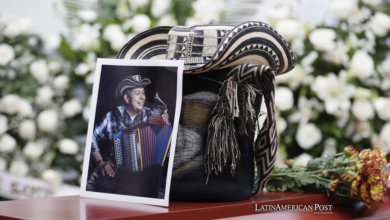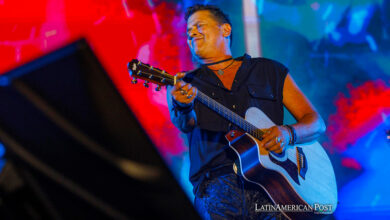Carlos Vives Serenades Santa Marta at 500: A Vallenato Homecoming by the Sea

Under a full moon and a sea of phone lights, Carlos Vives took the beach stage in his hometown of Santa Marta and turned a quincentennial concert into a roaring, salt-tinged anthem of memory, music, and a nation still dancing together.
A Stage Built on Sand and Memory
By the time the first chords rang out across Playa de Los Cocos, the sun had already vanished behind the Sierra Nevada, and the beach had transformed into something more than sand and surf. Trucks had arrived at dawn to flatten the terrain. LED towers blinked to life. Scaffolding rose like a temporary cathedral by the water’s edge. And on the stage, Carlos Vives, barefoot and dressed in white linen, raised a hand as cheers from thousands surged toward the tide.
“I dreamed of you so many times, Santa Marta,” he sang in his opening number, his voice catching in the sticky Caribbean air. The song, a debut titled “500 Años”, played over sweeping images of his hometown—palm groves, fishing boats, and the sea that never stops moving.
Backstage, speaking to EFE, the 63-year-old troubadour seemed as wide-eyed as the fans crowding the barricades. “When I rode my bike through this neighborhood as a kid, I never imagined this,” he said. “But the work’s not done. We still have to sing every day, without rest.”
For more than two hours, he did just that—blending vallenato’s folk pulse with electric guitar licks and even flashes of reggaeton. From balconies overlooking the beach, families danced with toddlers on their shoulders. A group of older women in floral dresses sang every word from folding chairs beneath a tamarind tree.
It wasn’t just a concert. It was a full-circle return.
A Night of Songs, Roots, and Samarian Pride
Vives didn’t just perform his hits—he curated a portrait of Santa Marta’s identity through the guests he welcomed and the stories he told between songs. Former players from Unión Magdalena, the local soccer team that captured its only national title in 1968, kicked signed balls into the crowd. Locals erupted into chants, reliving the moment the city tasted glory on the pitch.
Then came the rising stars. Samarian rapper Lalo Ebratt, crooner L’Omy, and children from the Barrio San Martín, decked in vibrant costumes with flapping wings, stepped into the spotlight. “These are the ‘periquitos,'” Vives beamed to EFE—”the little parrots keeping our music alive.”
The loudest applause of the night came for Niña Pastori, the Spanish flamenco singer Vives affectionately called “a cousin from across the ocean.” Their duet of the local classic “Santa Marta tiene tren pero no tiene tranvía” felt like time travel—part history lesson, part street party. “Spain and the Americas share rhythms,” he said. “We just call them different names.”
He also shared memories of his time touring Spain “top to bottom,” as he put it. “Everywhere I went, I saw pieces of my own story reflected.” The flamenco beat and the vallenato box met somewhere in the middle—between Cádiz and Colombia—and reminded the audience that musical bloodlines don’t end at borders.
An Eight-Minute Anthem for 500 Years
As the evening reached its peak, the stage fell into hush. Lights dimmed. Vives stepped forward and introduced “500 Años,” an eight-minute anthem co-written with Wayuu and Kankuamo youth, blending indigenous voices with coastal melodies. To help the crowd follow, organizers projected the lyrics across massive LED screens, over drone footage of the Sierra Nevada and sacred lagoons nestled in the mountains.
The Arhuaco stanza was delivered live by Gloria Izquierdo, a community leader dressed in a white tunic and traditional necklaces. She stepped into the spotlight and sang of rivers as ancestors, of mountains as memory.
“Indigenous wisdom,” she told EFE after the performance, “is Santa Marta’s oldest heartbeat. Tonight, we shared it with the world.”
The performance wasn’t perfect—twice, the stage monitors cut out. But instead of faltering, the crowd surged louder. As if on cue, thousands chanted a single phrase into the night: “¡Yo me quedo en Santa Marta!”—”I’m staying in Santa Marta!”
When the sound returned, it felt less like a fix and more like a revival.

More Than a Concert: A Movement in Song
The night was never just about music. It was about what music has meant—and still means—for Colombia.
Three decades ago, Carlos Vives rewired vallenato. With his 1993 reimagining of Rafael Escalona’s ballads, he took an accordion-driven genre once confined to Caribbean coastlines and injected it with rock, pop, and global appeal. That wave lifted artists like Shakira, Juanes, and dozens of others.
But Vives hasn’t just been a star—he’s been a builder. “When Carlos invites new artists onstage, booking agents take notice,” music producer Andrés León told EFE. At a time when the industry is saturated with manufactured pop, Vives insists on bringing rookies into the spotlight—some barely out of high school.
Through his Tras La Perla foundation, Vives also funds music schools, plants mangroves, and campaigns for the restoration of the Ciénaga Grande wetlands. That holistic mission—cultural, ecological, and communal—was stitched into the night’s visual tapestry. Between sets, the audience watched a short film: clips of Grammy wins, conservation efforts, and stadium shows in Miami, Madrid, and Medellín, all looped into one narrative.
It ended where it began—with Vives whispering into the mic: “Aquí están mis raíces.” Here lie my roots.
Fireworks launched out toward the anchored boats, percussion cracked like thunder, and the crowd didn’t scatter—they stood, arms around shoulders, singing into the night.
Also Read: Latin American Hit List 2025: Billboard’s Top 25 Songs Revealed
Carlos Vives didn’t just headline Santa Marta’s 500th. He gave it a voice, a soundtrack, a memory too big for cameras to capture. On a beach where stories have always started with the sea, he added another: a chorus of vallenato, rock, and indigenous wisdom, promising that the next half-millennium will have rhythm—and that Santa Marta, against all odds, will keep dancing.





